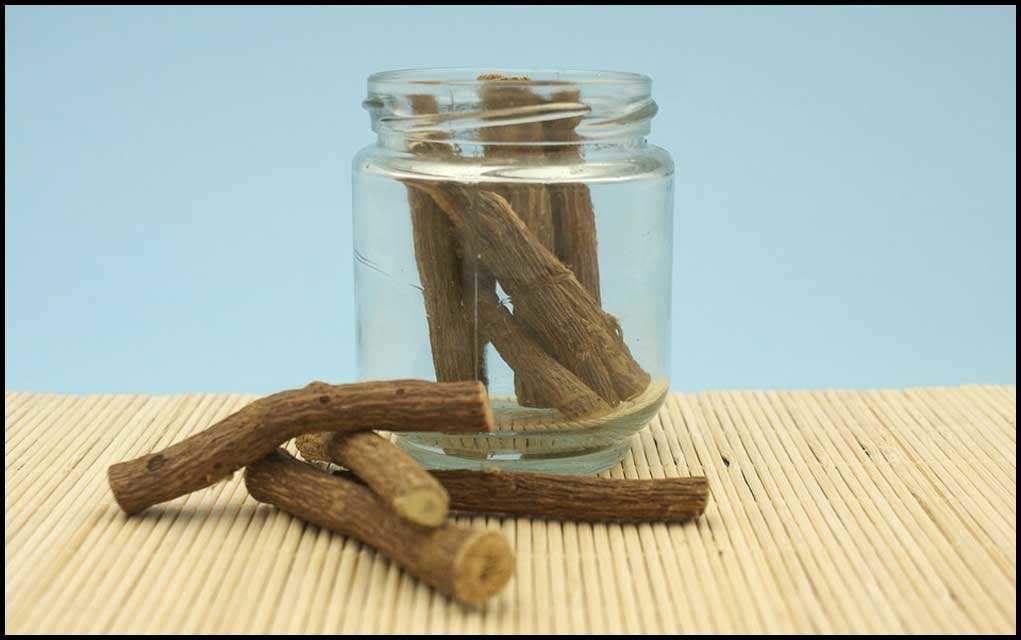
Even athletes and highly active people can suffer gastric ulcers and gastritis, an all too common inflammation of the lining of the stomach. And while it is important to see a physician if you are experiencing ulcers or gastritis, you may also take comfort in a plant remedy from antiquity, licorice root. Licorice root is the common name for Glycyrrhiza glabra, a perennial shrub native to Eurasia. The root is commonly used to make licorice candy, for flavoring in tobacco, liqueurs, beer, chewing gum, and soft drinks, and even as a foaming agent in fire extinguishers.
Due to its broad and popular use, licorice has been the subject of much study. The root is not only a flavoring, but a time-honored remedy as well. Licorice root and its extracts are made into bronchial and gastrointestinal remedies, and preparations for the liver, bile and urinary tract. Today licorice root is recognized as an effective remedy for inflammation of mucus membranes, and is recommended by world scientific bodies for relieving gastritis and ulcers.
Licorice root possesses demulcent (soothing inflamed or irritated tissue), anti-ulcer, spasmolytic (checking spasms), antitoxic, anti-inflammatory, and anti-allergenic properties. Specifically, glycyrrhizic acid and a related compound appear to accelerate the healing of gastric ulcers. Extracts of licorice root also show estrogenic activity (promotes production of female sex hormones), and demonstrate anti-tumor, anticonvulsive, and antibacterial properties.
The activity of licorice root is due to more than one compound. The root contains antioxidant and anti-inflammatory agents. Even licorice extract with its glycyrrhizin removed (deglycyrrhizinated) shows beneficial activity in treating duodenal and gastric ulcers.
Licorice root was recommended by the Greeks to treat ulcers, and by Arab physicians to ease the side effects of laxatives. As a traditional medicine, licorice root has been used for gastric and duodenal ulcers, sore throat, malaria, abdominal pain, insomnia, tuberculosis, sores, abscesses, food poisoning and cancer.
Licorice root plays and important role in Traditional Chinese Medicine (TCM), where it is used in numerous preparations. In TCM licorice root is considered an aid to longevity. In that system licorice is used to treat sore throat, carbuncles, toxic swelling, toxicosis in fetuses and children, diarrhea due to spleen deficiency, thirst due to stomach deficiency, cough due to dry lungs, and to ease palpitations.
Germany’s Commission E recommends the use of licorice root for gastric and duodenal ulcers, as does The British Herbal Compendium, which also indicates use of licorice root for chronic gastritis. Germany’s Commission E recommends a daily intake of Licorice root of; 5 – 15 grams of cut or powdered root, or dry extracts equivalent to 200 – 600 mg of glycyrrhizin. The Commission also advises against using Licorice for more than 4 – 6 weeks without the guidance of a physician.
Look for licorice root herbal products which specify the amount of glycyrrhizin in the product. This will help you to stay accurately within the Commission E dosage guidelines of 200 – 800 mg of glycyrrhizin daily.
References:
- Leung AY, Foster S. Encyclopedia of Common Natural Ingredients Used in Food, Drugs and Cosmetics, 2nd ed., (New York: John Wiley & Sons, Inc. 1996).
- Bruneton J. Pharmacognosy, Phytochemistry, Medicinal Plants. 2nd ed., (Paris: Lavoisier Publishing 1993).
- Evans, W.C., Trease and Evans’ Pharmacognosy, 13th ed., (Philadelphia, Bailliere Tindall, 1989) Wichtl M, Bisset NG (eds.). Herbal Drugs and Phytopharmaceuticals. Trans from 2nd German ed., (Stuttgart: Medpharm GmbH Scientific Publishers. 1994).
- Blumenthal M, Goldberg A, Brinckmann J (eds). Herbal Medicine: Expanded Commission E Monographs. 1st ed., (Newton, MA: Integrative Medicine Communications. 2000).
- Bown, Deni. The Herb Society Of America Encyclopedia of Herbs & Their Uses. (1st ed., (New York: Dorling Kindersley,1995). Agricultural Research Service, Dr. Duke’s Phytochemical and Ethnobotanical Databases.
- European Scientific Cooperative on Phytotherapy. ESCOP Monographs on the Medicinal Uses of Plant Drugs. 1st ed., (Exeter, U.K.: ESCOP 1997).
- Blumenthal M, Busse W, Goldberg A, Gruenwald J, Hall T. Riggins CW, Rister RS (eds.). The Complete German Commission E Monographs: Therapeutic Guide to Herbal Medicines. S. Klein, R.S. Rister (trans.). 1st ed.(Austin, TX: American Botanical Council. 1998).
Important Notice: This article was originally published at www.medicinehunter.com where all credits are due.
Disclaimer
The watching, interacting, and participation of any kind with anything on this page does not constitute or initiate a doctor-patient relationship with Dr. Farrah®. None of the statements here have been evaluated by the Food and Drug Administration (FDA). The products of Dr. Farrah® are not intended to diagnose, treat, cure, or prevent any disease. The information being provided should only be considered for education and entertainment purposes only. If you feel that anything you see or hear may be of value to you on this page or on any other medium of any kind associated with, showing, or quoting anything relating to Dr. Farrah® in any way at any time, you are encouraged to and agree to consult with a licensed healthcare professional in your area to discuss it. If you feel that you’re having a healthcare emergency, seek medical attention immediately. The views expressed here are simply either the views and opinions of Dr. Farrah® or others appearing and are protected under the first amendment.
Dr. Farrah® is a highly experienced Licensed Medical Doctor certified in evidence-based clinical nutrition, not some enthusiast, formulator, or medium promoting the wild and unrestrained use of nutrition products for health issues without clinical experience and scientific evidence of therapeutic benefit. Dr. Farrah® has personally and keenly studied everything she recommends, and more importantly, she’s closely observed the reactions and results in a clinical setting countless times over the course of her career involving the treatment of over 150,000 patients.
Dr. Farrah® promotes evidence-based natural approaches to health, which means integrating her individual scientific and clinical expertise with the best available external clinical evidence from systematic research. By individual clinical expertise, I refer to the proficiency and judgment that individual clinicians acquire through clinical experience and clinical practice.
Dr. Farrah® does not make any representation or warranties with respect to the accuracy, applicability, fitness, or completeness of any multimedia content provided. Dr. Farrah® does not warrant the performance, effectiveness, or applicability of any sites listed, linked, or referenced to, in, or by any multimedia content.
To be clear, the multimedia content is not intended to be a substitute for professional medical advice, diagnosis, or treatment. Always seek the advice of your physician or other qualified health providers with any questions you may have regarding a medical condition. Never disregard professional medical advice or delay in seeking it because of something you have read or seen in any website, video, image, or media of any kind. Dr. Farrah® hereby disclaims any and all liability to any party for any direct, indirect, implied, punitive, special, incidental, or other consequential damages arising directly or indirectly from any use of the content, which is provided as is, and without warranties.








